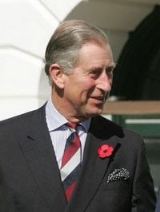
to the reigning monarch of the United Kingdom of Great Britain and Northern Ireland and the 15 other independent Commonwealth realm
s (and formerly of the United Kingdom of Great Britain and Ireland
, before that the Kingdom of Great Britain
and before that the Kingdom of England
). The current Prince of Wales is Prince Charles
, the eldest son of Queen Elizabeth II
.
The Prince of Wales currently has no formal public role or responsibility that has been legislated by Parliament
or otherwise delegated by the Monarchy
.
1282 Llywelyn the Last, the last native Prince of Wales, is killed at Cilmeri, near Builth Wells, south Wales.
1301 Edward of Caernarvon (later King Edward II of England) becomes the first English Prince of Wales.
1400 Owain Glyndŵr is declared Prince of Wales by his followers.
1471 Wars of the Roses: The Battle of Tewkesbury: Edward IV defeats a Lancastrian Army and kills Edward, Prince of Wales.
1499 Catherine of Aragon, is married by proxy to Arthur Tudor, Prince of Wales. Catherine is 13 and Arthur is 12.
1860 The Prince of Wales (later King Edward VII of the United Kingdom) visits the United States.
1890 The longest bridge in Great Britain, the Forth Rail Bridge in Scotland, measuring {{Convert|1710|ft|m}} long, is opened by the Prince of Wales, who later becomes King Edward VII.

